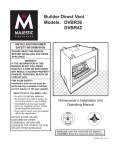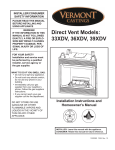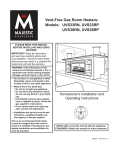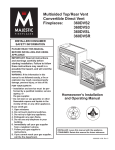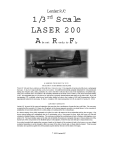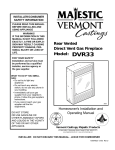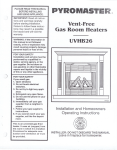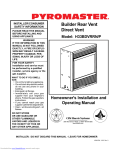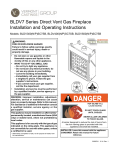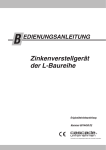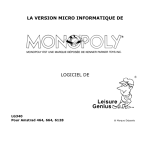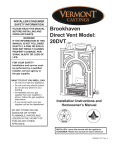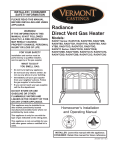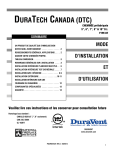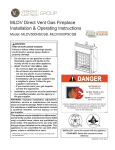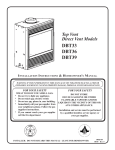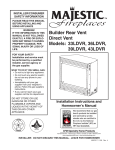Download Vermont Casting DVBR36 User's Manual
Transcript
Builder Direct Vent Models: DVBR36 DVBR42 INSTALLER/CONSUMER SAFETY INFORMATION PLEASE READ THIS MANUAL BEFORE INSTALLING AND USING APPLIANCE WARNING! IF THE INFORMATION IN THIS MANUAL IS NOT FOLLOWED EXACTLY, A FIRE OR EXPLOSION MAY RESULT CAUSING PROPERTY DAMAGE, PERSONAL INJURY OR LOSS OF LIFE. FOR YOUR SAFETY Installation and service must be performed by a qualified installer, service agency or the gas supplier. WHAT TO DO IF YOU SMELL GAS: • Do not try to light any appliance. • Do not touch any electric switch; do not use any phone in your building. • Immediately call your gas supplier from your neighbor’s phone. Follow the gas suppliers instructions. • If you cannot reach your gas supplier call the fire department. DO NOT STORE OR USE GASOLINE OR OTHER FLAMMABLE VAPORS AND LIQUIDS IN THE VICINITY OF THIS OR ANY OTHER APPLIANCE. Homeowner’s Installation and Operating Manual FP596A 1/14/99 D E S I GN C E RT I F I E D CE RTIFI E D INSTALLER: Leave this manual with the appliance. CONSUMER: Retain this manual for future reference. 20000584 1/07 Rev. 16 DVBR Series Direct Vent Gas Fireplace Table of Contents Please Read the Installation & Operating Instructions Before Using Appliance. Thank you and congratulations on the purchase of a CFM Corporation fireplace. IMPORTANT: Read all instructions and warnings carefully before starting installation. Failure to follow these instructions may result in a possible fire hazard and will void the warranty. Installation & Operating Instructions General Information ....................................................................................................................3 Fireplace Dimensions .................................................................................................................4 Locating Your Fireplace ..............................................................................................................6 Clearance to Combustibles .........................................................................................................6 Mantels ......................................................................................................................................6 Mantel Chart ...............................................................................................................................6 Hearth ......................................................................................................................................7 Framing and Finishing ................................................................................................................7 Final Finishing .............................................................................................................................7 Gas Specifications ......................................................................................................................7 Gas Inlet & Manifold Pressures ..................................................................................................7 High Elevations ...........................................................................................................................7 Gas Line Installation ...................................................................................................................7 Remote Switch Installation ..........................................................................................................8 EB-1 Electrical Box .....................................................................................................................8 Optional Top Vent Application .....................................................................................................8 General Venting Information General Venting ........................................................................................................................10 General Venting Information - Termination Location ................................................................. 11 General Information Assembling Vent Pipes .............................................................................12 How to Use the Vent Graph ......................................................................................................13 Rear Wall Vent Applications & Installation ................................................................................13 Vertical Sidwall Applications & Installation ................................................................................15 Below Grade Installation ...........................................................................................................19 DVBR36 Vertical Installation Baffle Adjustment ........................................................................19 Vertical Through-the-Roof Applications & Installation ...............................................................20 Venting Components .................................................................................................................22 Operating Instructions Glass Information ......................................................................................................................23 Glass Frame Removal ..............................................................................................................23 Glass Cleaning ..........................................................................................................................23 Replacement of Ceramic Hearth Panels ...................................................................................23 Installation of Logs ....................................................................................................................24 Ember Material Placement ........................................................................................................24 Lava Rock .................................................................................................................................24 Flame & Temperature Adjustment .............................................................................................25 Flame Characteristics ...............................................................................................................25 Inspecting the Venting System ..................................................................................................25 Lighting & Operating Instructions ..............................................................................................27 Troubleshooting ........................................................................................................................29 Fuel Conversion Instructions ....................................................................................................30 Maintenance Cleaning the Standing Pilot Control System .............................................................................32 Replacement Parts ..............................................................................................................................33 Optional Accessories FK-12 Fan Kit ............................................................................................................................35 Remote Controls .......................................................................................................................35 Ceramic Refractory Panels .......................................................................................................35 Decorative Glass Panels ...........................................................................................................36 Decorative Frame Trims ............................................................................................................36 Warranty ...............................................................................................................................................39 2 20000584 DVBR Series Direct Vent Gas Fireplace Installation Instructions This gas appliance should be installed by a qualified installer in accordance with local building codes and with current CSAB149.1 Installation codes for Gas Burning Appliances and Equipment. If the unit is being installed in a mobile home, the installation should comply with the current CAN/CSA Z 240.4 code. For U.S.A Installations follow local codes and/or the current National Fuel Gas Code. ANSI Z223.1/NFPA 54. In the Commonwealth of Massachusetts, all gas fitting and installation of this heater shall only be done by a licensed gas fitter or licensed plumber. FOR SAFE INSTALLATION AND OPERATION PLEASE NOTE THE FOLLOWING: 1. This fireplace gives off high temperatures and should be located out of high traffic areas and away from furniture and draperies. 2. Children and adults should be alerted to the hazards of the high surface temperatures of this fireplace and should stay away to avoid burns or ignition of clothing. 3. Children should be carefully supervised when in the same room as your fireplace. 4. Under no circumstances should this fireplace be modified. Parts removed for servicing should be replaced prior to operating this fireplace again. 5. Installation and any repairs to this fireplace must be performed by a qualified installer, service agency or gas supplier. A professional service person should be contacted to inspect this fireplace annually. Make it a practice to have all of your gas fireplaces checked annually. More frequent cleaning may be required due to excess lint and dust from carpeting, bedding material, etc. 6. Control compartments, burners and air passages in this fireplace should be kept clean and free of dust and lint. Make sure the gas valve and pilot light are turned off before you attempt to clean this fireplace. 7. The venting system (chimney) of this fireplace should be checked at least once a year and if needed your venting system should be cleaned. 8. Keep the area around your fireplace clear of combustible materials, gasoline and other flammable vapor and liquids. This fireplace should not be used as a drying rack for clothing, nor should Christmas stocking or decorations be hung in the area of it. 9. Under no circumstances should any solid fuels (wood, coal, paper or cardboard etc.) be used in this fireplace. 10. The flow of combustion and ventilation air must not be obstructed in any way. 11. When fireplace is installed directly on carpeting, vinyl tile or any combustible material other than wood, this fireplace must be installed on a metal or wood panel extending the full width and depth of the fireplace. 12. This fireplace requires adequate ventilation and combustion air to operate properly. 13. This fireplace must not be connected to a chimney flue serving a separate solid fuel burning fireplace. 14. When the fireplace is not in use it is recommended that the gas valve be left in the OFF position. 20000584 WARNING: Check with your electronics manufacturer before installing a television or other electronic device above this fireplace. This appliance may be installed in an aftermarket permanently located, manufactured home or mobile home, where not prohibited by local codes. This appliance is only for use with the type of gas indicated on the rating plate. This appliance is not convertible for use with other gases, unless a certified kit is used. The DVBR has been approved for mobile home installations. Proposition 65 Warning: Fuels used in gas, woodburning or oil fired appliances, and the products of combustion of such fuels, contain chemicals known to the State of California to cause cancer, birth defects and other reproductive harm. California Health & Safety Code Sec. 25249.6 IMPORTANT: PLEASE READ THE FOLLOWING CAREFULLY Remove any plastic from trim parts before turning the fireplace ON. It is normal for fireplaces fabricated of steel to give off some expansion and/or contraction noises during the start up or cool down cycle. Similar noises are found with your furnace heat exchanger or car engine. It is not unusual for your gas fireplace to give off some odor the first time it is burned. This is due to the manufacturing process. Please ensure that your room is well ventilated -open all windows. It is recommended that you burn your fireplace for at least ten (10) hours the first time you use it. If the optional fan kit has been installed, place the fan switch in the “OFF” position during this time. 3 DVBR Series Direct Vent Gas Fireplace Fireplace Dimensions (Installed as Top Vent) Rough Opening Depth S M N G 5/ 8” (1 6 m m ) ���" T CL H Q S I R ���" Rough Opening Height 5/8” (16 mm) P - Rough Opening Width ���" E B O Electrical Access C D Gas Line Access F J K K L A Fig. 2 Fireplace specifications and framing dimensions. Ref. A B C D E F G H I J K L M N O P Q R S T 4 584 DVBR36 Specs - top vent 40” (1016 mm) 2/14/02 djt 36” (614 mm) 36” (914 mm) (591 mm) 23¹⁄₄” 6³⁄₈” (162 mm) 6³⁄₈” (162 mm) 20” (508 mm) 6³⁄₄” (172 mm) 22” (559 mm) (337 mm) 13¹⁄₄” 3” (76 mm) 6¹⁄₂” (165 mm) 4” (102 mm) Dia. 7” (178 mm) Dial. Framing Dimensions 40¹⁄₂” (1029 mm) 41” (1041 mm) 20¹⁄₂” (521 mm) (1645 mm) 64³⁄₄” 45³⁄₄” (1162 mm) 32³⁄₈” (822 mm) DVBR42 46” (1168 mm) 36” (914 mm) 42” (1067 mm) 24¹⁄₄” (616 mm) 6³⁄₈” (162 mm) 5³⁄₈” (137 mm) 20” (508 mm) 6³⁄₄” (172 mm) 28” (711 mm) 13¹⁄₄” (337 mm) 3” (76 mm) 6¹⁄₂” (165 mm) 4” (102 mm) Dia. 7” (178 mm) Dia. 40¹⁄₂” 47” 20¹⁄₂” 69¹⁄₂” 49” 35¹⁄₄” (1029 mm) (1194 mm) (521 mm) (1765 mm) (1245 mm) (895 mm) 20000584 DVBR Series Direct Vent Gas Fireplace Fireplace Dimensions (Installed as Rear Vent) �� Rough Opening Depth R H P G m 6 5/ 8” (1 S R m ) ���" Q ���" Rough Opening Height 5/8” (16 mm) O - Rough Opening Width ���" E N B Electrical Access C L D F I J M Gas Line Access K A J Fig. 3 Fireplace specifications and framing dimensions. Ref. A B C D E F G H I J K L M N O P Q R S 20000584 DVBR36 584 40” (1016 mm) Specs - rear vent 2/14/02 djt 36” (614 mm) 36” (914 mm) (591 mm) 23¹⁄₄” 6³⁄₈” (162 mm) 6³⁄₈” (162 mm) 20” (508 mm) 22” (559 mm) (337 mm) 13¹⁄₄” 3” (76 mm) 6¹⁄₂” (165 mm) 29¹⁄₂” (749 mm) 30¹⁄₄” (768 mm) Framing Dimensions 40¹⁄₂” (1029 mm) 41” (1041 mm) 20¹⁄₂” (521 mm) 64³⁄₄” (1645 mm) (1162 mm) 45³⁄₄” 32³⁄₈” (822 mm) DVBR42 46” (1168 mm) 36” (914 mm) 42” (1067 mm) 23¹⁄₄” (591 mm) 6³⁄₈” (162 mm) 5³⁄₈” (137 mm) 20” (508 mm) 28” (711 mm) 13¹⁄₄” (337 mm) 3” (76 mm) 6¹⁄₂” (165 mm) 29¹⁄₂” (749 mm) 30¹⁄₄” (768 mm) 40¹⁄₂” 47” 20¹⁄₂” 69¹⁄₂” 49” 35¹⁄₄” (1029 mm) (1194 mm) (521 mm) (1765 mm) (1245 mm) (895 mm) 5 DVBR Series Direct Vent Gas Fireplace Locating Your Fireplace V W X Y Y E A C Y Z B X A B C D E Fireplace D B F Top of Combustion Chamber LU584-1 Fig. 1 Locating Gas Fireplace A) Flat on wall D) *Room divider Y) 6” minimum B) Cross corner E) *Flat on wall corner LU584-1 Locating unit C) **Island 2/4/99 djt F) Chase installation Note (Fig. 1): ** Island (C) and Room Divider (D) installation is possible as long as the horizontal portion of the vent system (X) does not exceed 20’ (610 cm). See details in Venting Section. * When you install your fireplace in(D) Room divider or (E) Flat on wall corner positions (Y), a minimum of 0” (0mm) clearance must be maintained from the perpendicular wall and the front of the fireplace. CFM146a Bottom of Door Trim Mantel Chart Ref. V W X Y Z CFM146 Mantel DV Mantel Chart 7/5/01 sta Shelf Depth Ref. 14” (356 mm) A 12” (305 mm) B 10” (254 mm) C 8” (203 mm) D E 1¹⁄₂” (38 mm) Mantel from Top of Comb. Chamber 18” (457 mm) 16” (406 mm) 14” (356 mm) 12” (305 mm) 8” (203 mm) Fig. 4a Combustible mantel minimum installation. Clearance to Combustibles Appliance Top ......................................................... 0” (0 mm) Bottom ..................................................... 0” (0 mm) Side ......................................................... 0” (0 mm) Back ........................................................ 0” (0 mm) Perpendicular Sidewall ........................... 0” (0 mm) Top of unit to ceiling .......................... 36” (914 mm) Front of unit to combustibles ............. 36” (914 mm) Venting Concentric sections of DV Vent ................... 1” (25 mm) Nonconcentric sections of DV Vent Sides and bottom ................................. 1” (25 mm) Top ........................................................ 2” (51 mm) J Black Surround Face CFM164a Side of CFM164aChamber Combustion Mantel Leg Chart 06/22/01 sta Mantel Leg M N O I H G F K L Mantels The height that a combustible mantel is fitted above the fireplace is dependent on the depth of the mantel. This also applies to the distance between the mantel leg (if fitted) and the fireplace. For the correct mounting height and widths, refer to Figures 4a and 4b and the Mantel Chart below. The distances and reference points are not affected by the fitting of a bay window front trim kit. Noncombustible mantels and legs may be installed at any height and width around the appliance. When using paint or lacquer, it must be heat resistant to prevent discoloration. 6 CFM170 Ref. F G H I J Fig. 4b Mantel Leg Mantel Leg from Side Depth Ref. of Combusion Opening 14” (356 mm) K 14” (356 mm) CFM170 DVmm) Builder FrontL 12” (305 12” (305 mm) View 10” (254 mm) M 10” (254 mm) 8” (203 mm) N 8” (203 mm) (89 mm) 4” (102 mm) O 3¹⁄₂” Combustible mantel minimum installation. 20000584 DVBR Series Direct Vent Gas Fireplace Gas Specifications Hearth A hearth is not mandatory but is recommended for aesthetic purposes. We recommend a noncombustible hearth which projects out 12” (305 mm) or more from the front of the fireplace. Cold climate installation recommendation: When installing this unit against a noninsulated exterior wall or chase, it is mandatory that the outer walls be insulated to conform to applicable insulation codes. Framing and Finishing Check fireplace to make sure it is levelled and properly positioned. NOTE: If the optional Metro Face Kit (DVBR36 only) is to be installed, the fireplace may be placed on a 4” (102 mm) raised platform. Raising the fireplace will give the best aestethic appearance but is not required. To mount the appliance: 1. Choose the location. 2. Nailing flanges are supplied with the fireplace (found on the fireplace hearth). To level the box and secure it firmly in place, remove the nailing flanges from the hearth and install at the sides of the fireplace as shown in Figure 5. Model DVBR36RN DVBR36RP DVBR42RN DVBR42RP Fuel Natural Gas Propane Natural Gas Propane Gas Control Millivolt Hi/Lo Millivolt Hi/Lo Millivolt Hi/Lo Millivolt Hi/Lo Max. Input B.T.U.H 24,000 24,000 27,000 27,000 Min. Input B.T.U.H. 16,000 17,500 18,000 19,700 Gas Inlet & Manifold Pressures Minimum Inlet Pressure Maximum Inlet Pressure Manifold Pressure Natural 5.5” w.c. 14.0” w.c. 3.5” w.c. LP 11.0” w.c. 14.0” w.c. 10.0” w.c. DVBR36 / DVBR42 Certified to ANSI Z21.88-2005 / CSA 2.33-2005 Vented Gas Fireplace Heater Units: GFCN3J0, GFCN3M0 High Elevations Input ratings are shown in BTU per hour and are certified without deration for elevations up to 4,500 feet (1,370m) above sea level. For elevations above 4,500 feet (1,370m) in USA, installations must be in accordance with the current ANSI Z223.1/NFPA 54 and/or local codes having jurisdiction. In Canada, please consult provincial and/or local authorities having jurisdiction for installations at elevations above 4,500 feet (1,370m). Nail Top Standoffs Nail Sidenailing Flanges FP549 Fig. 5 Nailing flanges. Final Finishing FP549 nailing flange Noncombustible materials such as brick and tile can be 1/05 extended over the black face of the unit (Do not cover the glass door.) If a Trim Kit is to be installed, brick and tile will have to be installed flush with the side of this appliance. 20000584 Gas Line Installation When purging gas line the front glass must be removed. The gas pipeline can be brought in through the right side of the appliance. Knockouts are provided at convenient locations to allow for the gas pipe installation and testing of any gas connection. The gas line connection can be made with 3/8” copper tubing, 1/2” rigid pipe or an approved flex connector. Since some municipalities have additional local codes, it is always best to consult your local authority and the CSA-B149.1 installation codes. For US installations consult the current National Fuel Gas Code, ANSI Z223.1/NFPA 54. 7 DVBR Series Direct Vent Gas Fireplace EB-1 Electrical Box 1/2” Gas Supply 1/2” NPT X 1/2” Flare Shut-off Valve The fireplace, when installed, must be electrically connected and grounded in accordance with local codes or, in the absence of local codes, with the current CSA C22.1 Canadian Electrical Code. 3/8” Flex line (from valve) FP297A Fig. 6 Typical gas supply installation. Always check for gas leaks with a mild soap and water solution applied with a brush no larger than 1” (25 mm). Never FP297A INSTA VENT FREE with a spray apply soap and water solution UVHB26 SUPPLY bottle. Do not use an GAS open flame for leak 7/1/98 testing. The fireplace valve must not be subjected to any test pressures exceeding 1/2 psi. Isolate or disconnect this or any other gas appliance control from the gas line when pressure testing. The gas control is equipped with a captured screw type pressure test point, therefore it is not necessary to provide a 1/8” test point up stream of the control. When using copper or flex connector use only approved fittings. Always provide a union when using black iron pipe so the gas line can be easily disconnected for burner or fan servicing. (Fig. 6) See the gas specifications for pressure details and ratings. Remote Switch Installation Do not wire the remote ON/OFF wall switch for this gas appliance into a 120v power supply. 1. Thread wire through the electrical knockout located on either side of fireplace. Do not cut wire or insulation on metal edges. Ensure that wire is protected. Run the other end to a conveniently located wall receptacle box. 2. Attach wire to switch and install switch into receptacle box. Attach cover plate to switch. 3. Connect wiring to gas valve. (Fig. 7) For USA installations, follow the local codes and the national Electrical Code ANSI/NFPA No. 70. It is strongly suggested that the wiring of the EB-1 Electrical Junction Box be carried out by a licensed electrician. Ensure that the power to the supply line has been disconnected before commencing this procedure. EB1 (Receptacle) Hook-Up 1. Remove contents from plastic bag. Remove knockout in center of electrical box. Remove coverplate from fireplace and knockout. Insert connector through coverplate, plate and box. Screw nut on connector with screws provided (2) to secure the coverplate to the plate. 2. Connect black positive wire to brass screw (polarized side) of receptacle. The white wire is connected to chrome screw. The ground wire is connected to green ground screw of the receptacle. Fit receptacle into electrical box. 3. Screw cover plate provided to electrical box. 4. Secure receptacle to fireplace. INSIDE ELECTRICAL BOX ����� ������ �� OUTSIDE Thermopile IT F UN NT O FRO FP580 Fig. 9 EB-1 receptacle. Gas Valve Switch W584-9 W584-9 Fig. 7 Remote switch wiring diagram for R models. WIRING DIAGRAM 1/8/99 djt 8 11/9/99 added thermopile FP580 INSTA VENT FREE EB1 JUNCTION BOX 11/18/97 20000584 DVBR Series Direct Vent Gas Fireplace Optional Top Vent Application The DVBR36/42 fireplace is shipped as a rear vent unit. If the layout requires a top vent, convert the unit following the steps below. DVBR36 1. Remove the eight (8) screws securing outer collar adapter to fireplace. (Be careful not to damage insulation.) (Fig. 10) 2. Set outer collar adapter aside. Rear View Remove Screws (4) 6. Secure flue cover to back of flue outlet. Be sure to replace gasket. (Fig. 12) 7. Install flue pipe to top of unit with four (4) screws. Be sure to replace gasket. (Fig. 12) 8. Set insulation in back of unit foil side down. 9. Secure outer collar adapter to unit with the round collar on top, secure with eight (8) screws. NOTE: Be sure not to damage any gasket material. Flue Pipe Flue Pipe Outer Collar Adapter Replace Screws (4) Replace Screws (4) Flue Pipe Foil Side DVT584-604 Insulation Fig. 12 Replace flue cover and flue pipe. Remove Screws (4) DVT584-602 Fig. 10 Remove screws from outer collar adapter. DVT584-602 3. Remove insulation on top of collector box. Adapter (Fig. 11) Outer Collar Flue Pipe 4. Remove the four (4) screws securing flue cover to 3/11/99 top of unit and remove flue cover. (Fig. djt 11) DVT584-604 Outer Collar Adapter Flue Pipe 3/11/99 djt 5. Remove the four (4) screws securing flue pipe to back of unit. Remove flue pipe. (Fig. 11) Insulation DVT584-605 Fig. 13 Completed conversion. Remove Screws (4) Flue Cover Flue Pipe Remove Screws (4) DVT584-605 Outer Collar Adapter Flue Pipe completed 3/11/99 djt DVT584-603 Fig. 11 Remove flue cover and flue pipe. DVT584-603 Outer Collar Adapter Flue Pipe 3/11/99 djt 20000584 9 DVBR Series Direct Vent Gas Fireplace DVBR42 Remove Insulation 1. Remove the seven (7) screws securing the heat shield cover plate to the fireplace. (Fig. a) Discard the heat shield cover plate. Remove Screws (7) Heat Shield Cover Plate FP1543 Fig. b Remove and discard insulation. FP1542 Fig. a Remove screws securing heat shield cover plate. Discard cover plate. 2. Carefully remove the square piece of insulation along the FP1542 perforations. (Fig. b) Discard insulation. 3. Remove the eight (8) screws securing outer collar DVBR42 heat shld adapter to fireplace. (Be careful not to damage insucover lation.) (Fig. 10) plate 1/05 4. Set outer collar adapter aside. 5. Remove insulation on top of collector box. (Fig. 11) FP1543 6. Remove the four (4) screws securing flue cover to top of unit andremove remove flue cover. (Fig. 11) insulation 7. Remove the four (4) screws securing flue pipe to 1/05 back of unit. Remove flue pipe. (Fig. 11) 8. Secure flue cover to back of flue outlet. Be sure to replace gasket. (Fig. 12) 9. Install flue pipe to top of unit with four (4) screws. Be sure to replace gasket. (Fig. 12) 10. Set insulation in back of unit foil side down. 11. Secure outer collar adapter to unit with the round collar on top, secure with eight (8) screws. NOTE: Be sure not to damage any gasket material. General Venting Your fireplace is approved to be vented either through the side wall, or vertical through the roof. • Only CFM Corporation venting components specifically approved and labelled for this fireplace may be used. • Venting terminals shall not be recessed into a wall or siding. • Horizontal venting which incorporates the twist lock pipe must be installed on a level plane without an inclining or declining slope. • Horizontal venting which incorporates the use of flex venting shall have an inclining slope from the unit of 1/2” (13 mm) per12” (305 mm). 10 There must not be any obstruction such as bushes, garden sheds, fences, decks or utility buildings within 24” from the front of the termination hood. Do not locate termination hood where excessive snow or ice build up may occur. Be sure to check vent termination area after snow falls, and clear to prevent accidental blockage of venting system. When using snow blowers, make sure snow is not directed towards vent termination area. Location of Vent Termination It is imperative the vent termination be located observing the minimum clearances as shown on the following page. 20000584 DVBR Series Direct Vent Gas Fireplace General Venting Information - Termination Location INSIDE CORNER DETAIL G V H A N N D L V E C B V F B ����� ������ B V Ope Operable rable V B B V B J M X I A CFM145a V VENT TERMINATION V Fixed Closed X AIR SUPPLY INLET A = Clearance above grade, veranda, porch, deck, or balcony B = Clearance to window or door that may be opened C = Clearance to permanently closed window D = Vertical clearance to ventilated soffit located above the terminal within a horizontal distance of 2 feet (610mm) from the center line of the terminal E = Clearance to unventilated soffit F = Clearance to outside corner G = Clearance to inside corner (see next page) H = Clearance to each inside of center line extended above meter/regulator assembly Canadian CFM145a DV (30cm) Termin Location 12” 5/01/01 Rev. 12/05/01 sta V K X AREA WHERE TERMINAL IS NOT PERMITTED Installations1 US Installations2 12” (30cm) 6” (15cm) for appliances < 10,000Btuh (3kW), 12” (30cm) for appliances > 10,000 Btuh (3kW) and < 100,000 Btuh (30kW), 36” (91cm) for appliances > 100,000 Btuh (30kW) appliances > 50,000 Btuh (15kW) 12” (305mm) recommended to prevent window condensation 6” (15cm) for appliances < 10,000 Btuh (3kW), 9” (23cm) for appliances > 10,000 Btuh (3kW) and < 50,000 Btuh (15kW), 12” (30cm) for 18” (458mm) 18” (458mm) 12” (305mm) see next page see next page 3’ (91cm) within a height of 15’ (5m) above the meter/regulator assembly 12” (305mm) see next page see next page 3’ (91cm) within a height of 15’ (5m) above the meter/regulator assy 3’ (91cm) 6” (15cm) for appliances < 10,000 Btuh (3kW), 9” (23cm) for appliances > 10,000 Btuh (3kW) and < 50,000 Btuh (15kW), 12” (30cm) for appliances > 50,000 Btuh (15kW) 3’ (91cm) above if within 10’ (3m) horizontally 7’ (2.13m)† I = Clearance to service regulator vent outlet J = Clearance to nonmechanical air supply inlet to building or the combustion air inlet to any other appliances 3’ (91cm) 6” (15cm) for appliances < 10,000 Btuh (3kW), 12” (30cm) for appliances > 10,000 Btuh (3kW) and < 100,000 Btuh (30kW), 36” (91cm) for appliances > 100,000 Btuh (30kW) K = Clearance to a mechanical air supply inlet 6’ (1.83m) 12” (305mm) recommended to prevent window condensation L = Clearance above paved sidewalk or paved 7’ (2.13m)† driveway located on public property M = Clearance under veranda, porch, deck or 12” (30cm)‡ 12” (30cm)‡ balcony N = Clearance above a roof shall extend a minimum of 24” (610mm) above the highest point when it passes through the roof surface, and any other obstruction within a horizontal distance of 18” (450mm). 1 In accordance with the current CSA-B149 Installation Codes 2 In accordance with the current ANSI Z223.1/NFPA 54 National Fuel Gas Codes † A vent shall not terminate directly above a sidewalk or paved driveway which is located between two single family dwellings and serves both dwellings ‡ only permitted if veranda, porch, deck or balcony is fully open on a minimum 2 sides beneath the floor: NOTE: 1. Local codes or regulations may require different clearances. 2. The special venting system used on Direct Vent appliances are certified as part of the appliance, with clearances tested and approved by the listing agency. 3. CFM Corporation assumes no responsibility for the improper performance of the appliance when the venting system does not meet these requirements. Fig. 14 Vent termination clearances. 20000584 11 DVBR Series Direct Vent Gas Fireplace Termination Clearances Termination clearances for buildings with combustible and noncombustible exteriors. Inside Corner Alcove Applications* Outside Corner G= Combustible 6" (152 mm) G F= Combustible 6" (152 mm) Noncombustible 2" (51 mm) V Noncombustible 2" (51 mm) V C V E O F Balcony with perpendicular side wall Balcony with no side wall D C E = Min. 6” (152 mm) for non-vinyl sidewalls Min. 12” (305 mm) for vinyl sidewalls O = 8’ (2.4 m) Min. M M V V P M= Combustible & Noncombustible 12" (305 mm) Combustible & Noncombustible M = 24" (610 mm) P = 20” (508 mm) No. of Caps 1 2 3 4 DMin. 3’ (.9 mm) 6’ (1.8 m) 9’ (2.7 m) 12’ (3.7 m) CMax. 2 x DActual 1 x DActual 2/3 x DActual 1/2 x DActual DMin. = # of Termination caps x 3 CMax. = (2 / # termination caps) x DActual 584-15 *NOTE: Termination in an alcove space (spaces open only on one side and with an overhang) is permitted with the dimensions specified for vinyl or non-vinyl siding and soffits. 1. There must be a 3’ (914 mm) minimum between termination caps. 2. All mechanical air intakes within 10’ (1 m) of a termination cap must be a minimum of 3’ (914 mm) below the termination cap. 3. All gravity air intakes within 3’ (914 mm) of a termination cap must be a minimum of 1’ (305 mm) below the termination cap. Fig. 15 Termination clearances. General Information Assembling Vent Pipes Canadian Installations The venting system must be installed in accordance with the current CSA-B149.1 installation code. USA Installations The venting system must conform to local codes and/or the current National Fuel Code ANSI Z223.1/NFPA 54. Only venting components manufactured by CFM Corporation may be used in Direct Vent systems. * Be sure the vent is actually crushed before proceeding. Apply a tug to be sure the vent will not slip off the collars. Repeat process with 7” flex vent pipe. The same procedure must be performed on the vent side. Apply High Temperature Sealant Flex Vent Pipes Before joining the flex vent pipe to the unit, apply a bead of high temperature sealant* (provided) to the 4” pipe exiting the fireplace. Secure flex vent pipe in place with a hose clamp (provided). *Be sure the flex pipe overlaps at least 1” (25mm) onto the collars of the fireplace and termination. If the termination has an internal bead, be sure to overlap and secure 1” (25 mm) past the bead. 12 Hose Clamp FP1471 Fig. 16 Apply high temperature sealant to 4” and 7” pipes. 20000584 DVBR Series Direct Vent Gas Fireplace Twist Lock Pipes 30 When using CFM Corporation twist-lock pipe, it is not necessary to use silicone to seal the twist-lock joints. The only areas that need silicone are the collars on the fireplace, the telescoping pipe (if used) and the horizontal termination connection (when necessary). The female (flared) end secures to the fireplace first with the male end away from the fireplace. 29 28 27 26 25 24 Vertical Dimension from the Floor of the Unit to the Center of the Horizontal Vent Pipe 23 22 To join the pipes together, simply align the beads of the male end with the grooves of the female end, twisting the pipe until the flange on the female end touches the external bead on the male end. Secure the joints with three (3) sheet metal screws. (Fig. 17) To make assembly easier, apply lubricant (vaseline or similar) on the male end of the twist-lock pipe. 21 20 19 18 17 16 15 14 13 eg: A 12 Female End Male End 11 10 9 8 7 eg: B 6 5 4 3 Screw Holes TWL100 3 Fig. 17 Twist-Lock pipe joints. How to Use the Vent Graph The Vent Graph should be read in conjunction with the following vent installation instructions to determine the TWL100 relationship between the vertical and horizontal dimenTwist Lock Pipe sions to the vent system. 3/12/99 djt 1. Determine the height of the center of the horizontal vent pipe exiting through the outer wall. Using this dimension on the Sidewall Vent Graph (Fig. 18), locate the point intersecting with the slanted graph line. 2. From the point of this intersection, draw a vertical line to the bottom of the graph. 3. Select the indicated dimension, and position the fireplace in accordance with same. EXAMPLE A: If the vertical dimension from the floor of the unit is 11 feet (3352 mm) the horizontal run to the face of the outer wall must not exceed 14’ (4267 mm). EXAMPLE B: If the vertical dimension from the floor of the unit is 7’ (2133mm), the horizontal run to the face of the outer wall must not exceed 8¹⁄₂’ (2590 mm). 20000584 4 5 6 7 8 9 10 11 12 13 14 15 16 17 18 19 20 Horizontal Dimension from the Outside Face of the Wall to the Center of the Fireplace Vent Flange DV Graph Fig. 18 Sidewall venting graph. (Dimensions in feet.) Refer to Page 19 for venting requirements for snorkels. Rear Wall Vent Applications When installed as a rear vent unit this appliance may be vented directly to a termination located on the rear wall behind the appliance. • Only CFM Corporation venting components are ap- • • • proved to be used in these applications (See ‘Venting Components’ listed for different installation requirements). The maximum horizontal distance between the rear of the appliance (or end of the transition elbow in a corner application) and the outside face of the rear wall is 20” (508mm). (Fig. 19, 20 ) Only one 45° elbow is allowed in these installations. Minimum clearances between vent pipe and combustible materials are as follows: Top - 2” (51 mm) Sides - 1” (25 mm) Bottom - 1” (25 mm) 13 DVBR Series Direct Vent Gas Fireplace Vent Opening - Combustible Wall 9³⁄₈" (240 mm) 20” (506 mm) Max. Framing Detail 10³⁄₈" (265 mm) Top View Flat Installation Fireplace Hearth FP1188 Vent Opening - Noncombustible Wall Fig. 19 Rear vent application, no elbows. 7¹⁄₂" Dia. (191 mm) 20” (506 mm) Max. Fireplace Hearth VO584-100 Fig. 21 Locate vent opening on wall. VO584-100 Vent Opening 2/99 djt Max. Length 12” (294 mm) #8 Screws (2) Top View Corner Installation FP1188 Fig. 20 Rear vent application, one 45° elbow. Rear Wall Vent Installations Twist Lock Pipe Firestop #8 Screws (2) Step 1 Locate and cut the vent opening in the wall. For combustible walls first frame in opening. (Fig. 21) NOTE: When using flex vent, the opening will have to be measured according to the 1” (25 mm) rise in 24” (610 mm) vertical run. Combustible Walls: Cut a 10³⁄₈”H x 9³⁄₈” W (265 mm x 240 mm) hole through the exterior wall and frame as shown. (Fig. 21) Noncombustible Walls: Hole opening should be 7¹⁄₂” (191 mm) diameter. Zero clearance sleeve is only required for combustible walls. Step 2 Measure wall thickness and cut zero clearance sleeve parts to proper length (Maximum 12” / 305mm). Assemble sleeve to its maximum opening (10³⁄₈” x 9³₈”) and attach to firestop assembly. (Fig. 22) Step 3 Measure the horizontal length requirement for the venting including a 2” (51 mm) overlap, i.e. from the elbow to the outside wall face plus 2” (51 mm). (Fig. 20) 14 #8 Screws (2) Adjustable Zero Clearance Sleeve CFM135a Fig. 22 Adjustable zero clearance sleeve. Step 4 Install the 4” (102 mm) vent to the appliance collar and secure with three (3) sheet metal screws. Install the 7” (175 mm) vent pipe to the appliance collar and secure with three (3) sheet metal screws. It is not necessary to seal this connection. If a 45° elbow is being used attach the elbow to the appliance in the same manner then attach the venting to the elbow. It is critical that there is no downward slope away from the appliance when conCFM135 necting the vent orSleeve elbow. Zero Clearance Step 5 2/26/01 sta Guide the venting through the vent hole as you place the appliance in its installed position. Guide the 4” (102 mm) and 7” (175 mm) collar of the vent termination into the outer ends of the venting. Do not force the termination. If the vent pipes do not align with the termination, remove and realign the venting at the appliance flue collars. (Fig. 23) Attach the termination to the wall as outlined in the instruction sheet supplied with the termination. 20000584 DVBR Series Direct Vent Gas Fireplace Finished Wall These ends screwed to appliance These ends should be even 12" (305mm) 1/2" (13mm) Vent Termination FP1472 Fig. 25 There must be a 1” rise in 24” length. Vertical Sidewall Applications FP1005 Fig. 23 Side view ofFP1005 final unit location, twist lock pipe. Side View Vent Termination Rear Wall Vent Installations 1/25/00 djt Flex Vent Pipe Follow Steps 1 and 2 on Page 14. Step 3 Install the 4” (102 mm) flex vent pipe to the appliance collars described in “General Information Assembling Vent Pipes”, Page 12. If the installation requires a 45° angle, grasp the vent pipe close to the appliance collar and bend to 45°. DO NOT exceed 45°. (Fig. 24) Termination Flex Section Appliance Collars Since it is very important that the venting system maintain itsFP1472 balance between the combustion air intake and the gas exhaust, certain limitations rise flue in length as to vent configurations apply and must be strictly 4/04 djt adhered to. The Vent Graph, showing the relationship between vertical and horizontal side wall venting, will help to determine the various dimensions allowable. Minimum clearance between vent pipes and combustible materials is 1” (25 mm) on top, bottom and sides unless otherwise noted. When vent termination exits through foundations less than 20” (508mm) below siding outcrop, the vent pipe must flush up with the siding. It is best to locate the fireplace in such a way that minimizes the number of offsets and horizontal vent length. The horizontal vent run refers to the total length of vent pipe from the flue collar of the fireplace (or the top of the Transition Elbow) to the face of the outer wall. Horizontal plane means no vertical rise exists on this portion of the vent assembly. When installing the appliance as a rear vent unit, the 90° or 45° Transition Elbow attached directly to the rear of the unit is NOT INCLUDED in the following criteria and calculations, and unless specifically mentioned should be ignored when calculating venting layouts. • The maximum number of 90° elbows per side wall FP1473 Fig. 24 Grasp the vent pipe close to the collar and bend to 45° angle. Do not exceed 45°. Install the 7” vent pipe in the same manner as Step 2. NOTE: There must be a 1” (25 mm) rise in 24” (610 mm) length of flex vent. installation is three (3). (Fig. 26) • If a 90° elbow is fitted directly on top of the fireplace flange the maximum horizontal vent run before the termination or a vertical rise is 36” (914mm). (Fig. 27) Step 4 Assemble the flex vent to the collars on the termination FP1473 as you did on the appliance. corner flex install 4/04 djt 20000584 15 DVBR Series Direct Vent Gas Fireplace 3 x 90° Elbows 3 x 90° Elbows 7’ (178cm) A 10’ (254cm) B A + B = 17’ Max. FP1176 8’ (244cm) Fig. 26 Maximum three (3) 90° elbows per installation. 36" (914mm) Max. 36" (914mm) Max. V584-201 Fig. 29 Maximum vent run with elbows. FP1177 Fig. 27 Maximum horizontal runwith no rise. • If a 90° elbow is used in the horizontal vent run (level height maintained) the horizontal vent length is reduced by 36” (914mm). (Fig. 28, 29) This does Max 20" not apply if the 90° elbows are used to increase or redirect a vertical rise. (Fig. 26) Example: According to the vent graph (Page 15) the maximum horizontal vent length in a system with a 7¹⁄₂” (191mm) rise is 20” (508mm) and if a 90° elbow is required in the horizontal vent it must be reduced to 17’ (5.2m). In Figure 28 & 29, dimension A plus B must not be V584-201 greater than 17’ (5.2m) Horizontal Run 2/99 djtof 45° elbows permitted per • The maximum number side wall installation is two (2). These elbows can be installed in either the vertical or horizontal run. • For each 45° elbow installed in the horizontal run, the length of the horizontal run MUST be reduced by 18” (457mm). This does not apply if the 45° elbows are installed on the vertical part of the vent system. • The maximum number of elbow degrees in a system is 270°. (Fig. 30) Example: Elbow 1 = 90° Elbow 2 = 45° Elbow 3 = 45° Elbow 4 = 90° Total angular variation = 270° 90o 1 + 2 + 3 + 4 = 270° B A Max 20" 1 2 3 A + B = 17' (Max.) 4 7'6" 1 2 3 4 FP1178 Fig. 28 Horizontal run reduction. FP1180 Fig. 30 Maximum elbow usage. 16 20000584 DVBR Series Direct Vent Gas Fireplace Vertical Sidewall Installation Twist Lock Pipe Max. Length 12” (294 mm) Step 1 #8 Screws (2) Locate vent opening on the wall. It may be necessary to first position the fireplace and measure to obtain hole location. Depending on whether the wall is combustible or noncombustible, cut opening to size. (Fig. 31) (For combustible walls first frame in opening.) NOTE: When using flex vent, the opening will have to be measured according to the 1” (25 mm) rise in 24” (610 mm) vent run. Combustible Walls: Cut a 9³⁄₈”H x 9³⁄₈”W (238mm x 238mm) hole through the exterior wall and frame as shown. (Fig. 31) Noncombustible Walls: Hole opening must be 7¹⁄₂” (191 mm) in diameter. Vent Opening Combustible Wall 9³⁄₈” (240mm) Firestop #8 Screws (2) #8 Screws (2) Adjustable Zero Clearance Sleeve CFM135a Fig. 32 Adjustable zero clearance sleeve. Step 4 Apply a band of silicone to the inner and outer flue collars of the fireplace and using appropriate length of pipe section(s) attach to fireplace with three (3) screws. Follow with the installation of the inner and outer elbow, again secure joints as described in the “Connecting Vent Pipe” section. 9³⁄₈” (240mm) CFM135 Zero Clearance Sleeve 2/26/01 sta Framing Detail Fireplace Hearth X X Vent Opening Noncombustible Wall 7¹⁄₂” Dia. (190mm) Fireplace Hearth VO584-100 Fig. 31 Locate vent opening on wall. Step 2 Measure wall thickness and cut zero clearance sleeve parts to proper lengthVO584-100 (MAXIMUM 12” / 305mm). AsVenttoOpening semble sleeve and attach firestop with #8 sheet 2/99 djt firestop assembly. (Fig. metal screws (supplied). Install 29) Zero clearance sleeve is only required for combustible walls. FP1181 Fig. 33 Vertical height requirements. Step 5 Measure the horizontal length requirement including a 2” (50mm) overlap, i.e. from the elbow to the outside wall face plus 2” (50mm) (or the distance required if installing a second 90° elbow). (Fig. 34) Always install horizontal venting on a level plane. Step 3 Place fireplace into position. Measure the vertical height (X) required from the base of the flue collars to the center of the wall opening. (Fig. 33) 20000584 Step 6 Use appropriate length of pipe sections - telescopic or fixed - and install. The sections which go through the wall are packaged with the starter kit, and can be cut to suit if necessary. 17 DVBR Series Direct Vent Gas Fireplace Sealing vent pipe and firestop gaps with high temperature sealant will restrict cold air being drawn in around fireplace. spring 5” (127 mm) from the previously installed spring. Place the next spring 6” (152 mm) from the last spring. Finally place the last spring 12” (305 mm) from the last spring installed. (Fig. 35) X 4” Flex Vent Pipe 12" (305mm) X Spacer Spring 6" (152mm) 5" (127mm) 6���" (172mm) FP1182 Fig. 34 Horizontal length requirement. Step 7 Apply high temperature sealant to 4” (102 mm) and 7” (175 mm) collars or the termination one inch away from crimped end. Guide the vent terminations 4” and 7” collars into their respective vent pipes. Double check that the vent pipes overlap the collars by 2” (51 mm). Secure the termination to the wall with screws provided and caulk around the wall plate to weatherproof. As an alternative to screwing the termination directly to the wall, you may also use expanding plugs or an approved exterior construction adhesive. You may also attach the termination with screws through the inner body into the 4” vent pipe, however for this method, you must extend the 4” pipe approximately 6” (152 mm) beyond the outer face of the wall. Support horizontal pipes every 3’ (91 cm) with metal pipe straps. Vertical Sidewall Installation Flex Vent Pipe NOTE: The 40” (1016 mm) flex vent is used for 90° off the top of the unit then out the back wall. Follow Step 1 and 2 on Page 17. Step 3 Install the four (4) spacer springs on the 4” flex vent pipe. When installing the spacer springs around the 4” pipe, stretch the spring to approximately 15” (381 mm), wrap the spring around the pipe and interlock the ends of the spacer spring approximately 2” (51 mm). Measure 6³⁄₄” (172 mm) from the end of the pipe. Place the next 18 FP1474 Fig. 35 Install spacer springs. Step 4 Install the 4” (102 mm) flex vent pipe to the appliance FP1474 collar as described on Page 12. Secure the end with the first spring 6³⁄₄” (172 mm) fromsprings the flex pipe end to the spacer unit. 4/04 djt Step 5 Slide the 7” (178 mm) flex vent pipe over the 4” flex vent pipe and secure the 7” collar as described on Page 12. Step 6 Bend the flex pipe horizontal so the bottom of the horizontal pipe measure 6¹⁄₂” (165 mm) from the top of the unit immediately after the 90° formation. (Fig. 36) Be sure to follow the 1” (25 mm) rise in a 24” (610 mm) horizontal run rule. Step 7 Install the 4” flex then 7” flex to the termination. 6���" (165mm) FP1475 Fig. 36 Bend flex vent at 90° so horizontal portion is 6¹⁄₂” (165 mm) off top of unit. 20000584 DVBR Series Direct Vent Gas Fireplace Below Grade Installation When it is not possible to meet the required vent terminal clearances of 12” (305 mm) above grade level, a snorkel kit is recommended. It allows installation depth down to 7” (178 mm) below grade level. The 7” (178 mm) is measured from the center of the horizontal vent pipe as it penetrates through the wall. Ensure the sidewall venting clearances are observed. If venting system is installed below ground, we recommend a window well with adequate and proper drainage to be installed around the termination area. If installing a snorkel, a minimum 24” (610 mm) vertical rise is necessary. The maximum horizontal run with the 24” vertical pipe is 36” (914 mm). This measurement is taken from the collar of the fireplace (or transition elbow) to the face of the exterior wall. See the Sidewall Venting Graph for extended horizontal run if the vertical exceeds 24” (610 mm). 1. Establish vent hole through the wall (Fig. 31) 2. Remove soil to a depth of approximately 16” (406mm) below base of snorkel. Install drain pipe. Install window well (not supplied). Refill hole with 12” (305mm) of coarse gravel leaving a clearance of approximately 4” (102 mm) below snorkel. (Fig. 37) 3. Install vent system. 4. Ensure a watertight seal is made around the vent pipe coming through the wall. 5. Apply high temperature sealant caulking (supplied) around the 4” and 7” snorkel collars. 6. Slide the snorkel into the vent pipes and secure to the wall. 7. Level the soil so as to maintain a 4” (102 mm) clearance below snorkel. (Fig. 37) Zero Clearance Sleeve if Required Snorkel Foundation Recess Watertight Seal Around Pipe Wall Screws Sheet Metal Screws BG401 Fig. 38 Snorkel installation, recessed foundation. BG401 Vertical Through-the-Roof Applications Snorkel 2/10/99 djt This gas fireplace has been approved for: • Vertical installations up to 40’ (12m) in height. Up to a 10’ (3 m) horizontal vent run can be installed within the vent system using a maximum of two 90° elbows. (Fig. 41) • Up to two 45° elbows may be used within the hori- 7DVSK (Snorkel) zontal run. For each 45° elbow used on the horizontal plane, the maximum horizontal length must be reduced by 18” (450mm). Example: Maximum horizontal length: No elbows = 10’ (3 m) 1 x 45° elbow = 8.5’ (2.6 m) 2 x 45° elbows = 7’ (2.1 m) 4” Clearance Min. • A minimum of an 8’ (2.5 m) vertical rise is required. • Two sets of 45° elbow offsets may be used within the Firestop 7” Pipe Do not back fill around snorkel. A clearance of at least 4” must be maintained between the snorkel and the soil. If the foundation is recessed, use recess brackets (not supplied) for securing lower portion of the snorkel. Fasten brackets to wall first, then secure to snorkel with self drilling #8 x 1/2 sheet metal screws. It will be necessary to extend vent pipes out as far as the protruding wall face. (Fig. 38) Window Well Gravel • Drain Foundation Wall * A minimum of 24” (608 mm) vertical pipe must be installed when using the 7TDVSKS kit. BG400 • • vertical sections. From 0 to a maximum of 8’ (2.5 m) of vent pipe can be used between elbows. (Fig. 42) 7DVCS supports offsets. (Fig. 44) This application will require that you first determine the roof pitch and use the appropriate starter kit. (Refer to Venting Components List) The maximum angular variation allowed in the system is 270°. (Fig. 42) The minimum height of the vent above the highest point of penetration through the roof is 2’ (610mm). (Fig. 45) Refer to Note 2, Page 11. Fig. 37 Below grade installation. 20000584 BG400 Below grade installation 2/10/99 djt 10/19/99 added standoffs 19 DVBR Series Direct Vent Gas Fireplace 5. Place firestop(s) #7DVFS into position and secure. (Fig. 43) 6. Install roof support (Fig. 44) and roof flashing making sure upper flange of flashing is below the shingles. (Fig. 46) 7. Install appropriate pipe sections until above the flashing. (Fig. 46) 8. Install storm collar and seal around the pipe. 9. Add additional vent lengths for proper height. 10. Apply high temperature sealant to 4” and 7” collars of vent termination and install. Max. Height 40’ (12.2m) Min. Height 8’ (2.4m) Max. 10’ (3m) Max. Height 40’ (12.2m) Min. Height 8’ (2.4m) If there is a room above ceiling level, firestop spacers must be installed on both the bottom and the top side of the ceiling joists. If an attic is above ceiling level a 7DVAIS (Attic Insulation Shield) must be installed. The enlarged ends of the vent section always face downward. Max. 10’ (3m) Attic Insulation Shield FP1183 Fig. 41 Support straps for horizontal runs. 11” 11” Upper Floor Joist 1 + 2 + 3 + 4 = 270° 1 2 3 4 Ceiling Installation 1 Firestop Spacer 2 3 4 Nails (4) VR404 Fig. 43 Place firestop spacer(s) and secure. FP1179 Fig. 42 Maximum elbow usage. Vertical Through-the-Roof Installation 1. Locate your fireplace. 2. Plumb to center of the (4”) 90° transition elbow (7DVRT90) from ceiling above and mark position. 3. Cut opening equal to 9³⁄₈" x 9³⁄₈" (240 x 240 mm). 4. Proceed to plumb for additional openings through the roof. In all cases, the opening must provide a minimum of 1” (25 mm) clearance to the vent pipe, i.e., the hole must be a minimum of 9³⁄₈" x 9³⁄₈" (240 x 240 mm). 20 Typical Roof Support Application Typical Ceiling Support Application FP1184 Fig. 44 VentingFP1184 supports. Typical roof/ceiling support apps. 20000584 DVBR Series Direct Vent Gas Fireplace Min. 2' (610 mm) 3 #5 Sheet Metal Screws per Joint Sealant Storm Collar 3 #5 Sheet Metal Screws per Joint Sealant Storm Collar TWL101a Fig. 46 Roof flashing. TWL101a Twist Lock Pipe 2/8/99 djt FP1185 Fig. 45 Minimum termination to roof clearance. 20000584 21 DVBR Series Direct Vent Gas Fireplace Venting Components 7TDVRVT - Through the wall Rear Vent Termination 584A venting components rear vent term 4/6/99 djt 584B Vent components Starter Kit 2/25/99 djt Starter Kit Model 7TDVSK - Sidewall Venting (Twist Lock Pipe) Model 7FDVSK - Sidewall Venting (Flex Vent Pipe) Model 7TTVTK/TV Hot Touch Termination Kit Model 7TDVTVTK/TV Cool Touch Termination Kit Starter Kit - Model 7TDVSKV - Vertical Venting for 7TDVSKV-A order 1/12 to 6/12 roof pitch for 7TDVSKV-B order 7/12 to 12/12 roof pitch for 7TDVSKV-F order flat roof Starter Kit for Below Grade Installation Model 7TDVSKS -Snorkel Kit (Twist Lock Pipe) Model 7FDVSKS -Snorkel Kit (Flex Vent Pipe) Starter Pipe Model 7TDVP 20/8 - 24” Starter Pipe Bulk Model 7FDVP 30/8 - 30” Flex Pipe Bulk 45o Elbow 7TDV45 for Rear Vent to Vertical Vent or Vertical/Horizontal Offsets 584C Vent components 584D 45 degree elbow Vent Components 2/25/99 djt 90 degree elbow 10/20/99 twistlock 2/25/99 djt 584E Venting Components 10/20/99 twist lock Telescope vent 584F 2/25/99 djt Venting Components 10/20/99 twist lock Pipe sections 2/25/99 djt 10/20/99 twist lock 584G Venting Components Firestop spacer 2/25/99 djt 584H Venting components attic insulation shield 2/25/99 djt 22 90o Transition Elbow 7TDVRT90 for Rear Vent to Vertical Vent 90° Elbow 7TDV90 Vertical/Horizontal Offset Telescopic vent sections 7TDVP1117 -11” to 17” adjustable length 7TDVP3567 -35” to 67” adjustable length Pipe sections for vertical or horizontal venting Model 7TDVP8” 4 per box Model 7TDVP12” 4 per box Model 7TDVP24” 4 per box Model 7TDVP36” Model 7TDVP48” Firestop Spacer Model 7DVFS Attic Insulation Shield Model 7DVAIS Vertical/Horizontal Combination Offset Support Model 7DVCS 20000584 584I vent components offset support DVBR Series Direct Vent Gas Fireplace Operating Instructions Glass Information Only glass approved by CFM Corporation may be used for replacement. Glass Frame Fireplace Front • The use of any non-approved replacement glass will • • • void all product warranties. Care must be taken to avoid breakage of the glass. Do not operate appliance with glass front removed, cracked or broken. Replacement glass (complete with gasket) is available through your CFM Corporation dealer and should only be installed by a licensed qualified service person. Clamps Glass Panel Glass Panel Pull Clamp Hook Glass Frame Removal 1. 2. 3. 4. Turn off gas. Let the fireplace cool if it has been operating. Remove valve cover. (Fig.47) Release the two (2) clamps at the bottom of the window frame by pulling back on the clamp handles. (Fig. 48) 5. Lift off the glass frame as shown. (Fig. 48) 6. To reinstall glass follow the above procedure in reverse. G584-501 Fig. 48 Glass panel removal. two or three times with a non-ammonia household G584-501 Remove(gas glass fireplace frame cleaner and warm water glass cleaner 2/99 djt is recommended). After initial use glass should be cleaned two or three times during heating season. Clean glass after first two weeks of operation. Do not clean glass when hot. Do not use abrasive cleaners. Do not strike or slam the glass. Valve Cover Replacement of Ceramic Hearth Panels Valve Pins Locating Holes 1. Remove glass. 2. Remove two (2) hex nuts securing grate to hearth pan. (Fig. 49) 3. Set left and right panels on hearth and bring towards front of unit. 4. Replace grate assembly. Grate Burner G584-500 Fig. 47 Valve cover location. Glass Cleaning G584-500 It is necessary to clean the glass periodically. During Remove valve cover start-up condensation, which is normal, forms on the djt and causes lint, dust and other inside of2/99 the glass airborne particles to cling to the glass surface. Also initial paint curing may deposit a slight film on the glass. It is therefore recommended the glass be cleaned 20000584 Hearth Panels Front of Unit H100 Fig. 49 Hearth panel location. H100 hearth Panels 3/15/99 djt 23 DVBR Series Direct Vent Gas Fireplace Installation of Logs Ember Material Placement Log Chart Separate the ember material into small pieces, roughly 1/2” in diameter and place onto the burner in front of the front logs. Do NOT pack down, leave in fluffy, loose condition for most realistic ember effect. Logs Left Log Right Log Right Rear Log Left Cross Log Log Top Right Right Cover Log Left Rear Log Center Log Left Front Log Left Cover Log DVBR36 20008817 20008819 20008818 20008820 -20008822 20008513 20008821 20008823 20008512 DVBR42 20008508 20008510 20008509 20008515 B29 20008515 20008816 20008514 20008823 20008512 1 . Remove front glass. (See “Glass Removal” Section, Fig. 48) 2. Remove logs from packaging. As with all plastics — these are not toys and should be kept away from children and infants. 3. Place Right Rear Log onto the two pem studs on the rear log support. Place the Left Rear Log on the left side of the rear log support and push the log up against the Right Rear Log. (Fig. 50) 4. Place the Left Log on the pem studs on the left side of the burner. Place the Right Log on the pem studs on the right side of the burner. (Fig. 51) 5. Place the front edge of the Left Cover Log on the front top edge of the burner between the last two left tines of the grate. Allow the bottom edge of the log to sit on the hearth. Place the Right Cover Log between the right two tines and rest the log up against the front face of the burner. (Fig. 52) 6. Place the Center Log between the second and third tines as shown. Place the v-notch on the left side of the Center Log against the left tine of the grate. Rest the right side of the Center log up against the face of the Right Log. (fig. 52) 7. Place the left Cross Log over the pin of the Right Rear Log and the pin of the Left Log. (Fig. 3) 8. DVBR42 only. Place the Right Cross Log over the Right Rear Log and the Right Log as shown. (Fig. 53) When positioned correctly, the right rear flame will come up through the hole in the Right Cross log. Carefully adjust the log as needed to allow the flame to come through the hole. 24 Lava Rock The lava rock provided with this fireplace must be placed on the firebox base around the burner assembly. Under no circumstances should this lava rock be placed on any part of the burner assembly. Right Rear Log Left Rear Log LG340 Fig. 50 Place Right and Left Rear Logs on rear log support. Right Log ����� ��������� ���� Left Log LG390 Fig. 51 Place Left and Right Logs on pem studs on burner. ����� ��������� ���� 20000584 DVBR Series Direct Vent Gas Fireplace Flame & Temperature Adjustment For fireplaces equipped with Hi/Lo valves, flame adjustment is accomplished by rotating the Hi/Lo adjustment knob located near the centre of the gas control. (Fig. 54 & 55) Flame Characteristics Right Cover Log Inspecting the Venting System Center Log LG391 Left Cover Log Fig. 52 Place Left and Right Cover Logs and Center Log on grate. ����� ��������� ���� To inspect the venting system, make sure the main gas valve is off. Remove glass frame (See Glass Frame Removal Section). Using a flashlight, check the area above the baffle in the combustion dome. Clean if necessary. LG392 Fig. 53 Place Left Front Log, Left Cross Log and Log Top Right. �� ��������� ���� Turn clockwise to increase flame height Turn counterclockwise to increase flame height LO Top logs must be placed properly onto �������� notches. �� Any foreign objects in the venting system, except those designed specifically for the venting system, may cause spillage of flue gases. Log Top Right (DVBR42 ONLY) Left Front Log Turn counterclockwise to decrease flame height This appliance venting system was designed and constructed to develop a positive flow adequate to remove flue gases to the outside atmosphere. HI Left Cross Log It is important to periodically perform a visual check of the pilot and the burner flames. Compare them to Figures 56, 57 & 58. If any of the flames appear abnormal call a service person. Turn clockwise to decrease flame height Fig. 55 flame adjustment knob for SIT valve. 3/8” - 1/2” FP390 FLAME ADJUSTMENT KNOB 11/21/96 HV102 Fig. 54 Flame adjustment knob for Honeywell valve. 20000584 HV102 Honeywell hi/lo knob 4/5/99 djt Fig. 56 Correct pilot flame appearance. 25 DVBR Series Direct Vent Gas Fireplace LG389 Fig. 57 Correct flame appearance for DVBR36 model. ����� ����������������� ���� LG387 Fig. 58 Correct flame appearance for DVBR42 model. 26 20000584 DVBR Series Direct Vent Gas Fireplace Lighting and Operating Instructions FOR YOUR SAFETY READ BEFORE LIGHTING WARNING:If you do not follow these instructions exactly, a fire or explosion may result causing property damage, personal injury or loss of life. A. This heater has a pilot which must be lit manually. When lighting the pilot follow these instructions exactly. B. BEFORE LIGHTING smell all around the heater area for gas. Be sure to smell next to the floor because some gas is heavier than air and will settle on the floor. WHAT TO DO IF YOU SMELL GAS • Do not try to light any fireplace • Do not touch any electric switch • Do not use any phone in your building • Immediately call your gas supplier from a neighbor’s phone. Follow the gas supplier’s instructions. • If you cannot reach your gas supplier, call the Fire Department C. Use only your hand to push in or turn the gas control knob. Never use tools. If the knob will not push in or turn by hand, do not try to repair it, call a qualified service technician. Applying force or any attempted repair may result in a fire or explosion. D. Do not use this fireplace if any part has been under water. Immediately call a qualified service technician to inspect the heater and to replace any part of the control system and any gas control which has been under water. Lighting Instructions 1. STOP! Read the safety information above. 2. Turn off all electrical power to the fireplace. 3. For MN/MP/TN/TP appliances ONLY, go on to Step 4. For RN/RP appliances turn the On/Off switch to “OFF” position or set thermostat to lowest level. 4. Open control access panel. 5. Push in gas control knob slightly and turn clockwise to “OFF”. 3/8" - 1/2" ON OFF OFF OFF 3 4 5 Euro SIT T LO PI ON 1 2 P OFF ilot PILOT 10. Push the control knob all the way in and hold. Immediately light the pilot by repeatedly depressing the piezo spark ignitor until a flame appears. Continue to hold the control knob in for about one (1) minute after the pilot is lit. Release knob and it will pop back up. Pilot should remain lit. If it goes out, repeat steps 5 through 8. SIT NOVA Honeywell 6. Wait five (5) minutes to clear out any gas. Then smell for gas, including near the floor. If you smell gas, STOP! Follow “B” in the safety information above. If you do not smell gas, go to the FP1067 lighting instruction next step. knobs 7. Remove glass door before lighting pilot. (See 3/9/01 djt Glass Frame Removal section). 8. Visibly locate pilot by the main burner. 9. Turn knob on gas control counterclockwise to “PILOT”. • If knob does not pop up when released, stop and immediately call your service technician or gas supplier. • If after several tries,FP1068 the pilot will not stay lit, turn the gas control knob to “OFF” and call Lighting instructions your service technician orPilots gas supplier. 11. Replace glass door. 12. Turn gas control knob to “ON” position. 13. For RN/RP appliances turn the On/Off switch to “ON” position or set thermostat to desired setting. 14. Turn on all electrical power to the fireplace. To Turn Off Gas To Heater 1. Turn the On/Off switch to Off position or set the thermostat to lowest setting. 2. Turn off all electric power to the fireplace if service is to be performed. 20000584 3. Open louvre assembly bottom. 4. Push in gas control knob slightly and turn clockwise to “OFF”. Do not force. 5. Close control access panel. 27 DVBR Series Direct Vent Gas Fireplace Troubleshooting – Honeywell VS8421 Remove window frame assembly before service work START CHECK Gas Supply On NO • Supply Line Hooked Up • Shutoff Valve Open YES • Lockout Has Engaged. Wait 60 Seconds And Try Again. Pilot Lights With Piezo Ignitor • For Spark At Electrode While NO • • YES PILOT STAYS LIT Depressing Piezo 1/8" Gap To Pilot Hood Needed. All Wiring Connections Replace Piezo Ignitor • For Air In The Lines • Thermopile Needs A Min. NO • • • 325mv. Adjust Pilot Flame Height. All Wiring Connections Replace Thermopile Thermocouple Needs A Min. Of 14mv YES PILOT LIGHTS MAIN BURNER YES • Valve Is Turned On • Wall Switch Is Not Turned On. NO • • • Watch For Grounded Wires! Thermopile Needs A Min. 325mv. Plugged Burner Orifice Defective Valve. Turn To Pilot, Meter Should Read Greater Than 100mv. If Not, Replace. SYSTEM OK 28 20000584 DVBR Series Direct Vent Gas Fireplace Troubleshooting the Gas Control System SIT NOVA 820 MILLIVOLT VALVE Note: Before trouble shooting the gas control system, be sure external gas shut off is in the “On” position. WARNING: BEFORE DOING ANY GAS CONTROL SERVICE WORK, REMOVE GLASS FRONT. SYMPTOM 1. Spark ignitor will not light 2. Pilot will not stay lit after carefully following lighting instructions. 3. Pilot burning, no gas to main burner 4. Frequent pilot outage problem. 20000584 POSSIBLE CAUSES CORRECTIVE ACTION A. Defective or misaligned electrode at pilot. Using a match, light pilot. If pilot lights, turn off pilot and push the red button again. If pilot will not light - check gap at electrode and pilot-should be 1/8” to have a strong spark. B. Defective ignitor (Push Button) Push Piezo Ignitor Button. Check for spark at electrode and pilot. If no spark to pilot, and elec trode wire is properly connected, replace ignitor. A. Defective pilot generator (thermocouple), remote wall switch. Check pilot flame. Must impinge on thermo couple/thermopile. Note: this pilot burner assem bly utilizes both-a thermocouple and a thermopile. The thermocouple operates the main valve operation (On and Off). Clean and or adjust pilot for maximum flame impingement on thermopile and thermocouple. B. Defective automatic valve Turn valve knob to “Pilot”. Maintain flow to pilot; milivolt meter should read greater than 10 mV. If the reading is okay and the pilot does not stay on, replace the gas valve. Note: An interrupter block (not supplied) must be used to conduct this test. A. Wall switch or wires defective Check wall switch and wires for proper connec tions. Jumper wire accross terminals at wall switch, if burner comes on, replace defective wall switch. If okay, jumper wires across wall switch wires at valve, if burner comes on, wires are faulty or connections are bad. B. Thermopile may not be generating sufficient millivoltage. 1. Be sure wire connections from thermopile at gas valve terminals are tight and thermopile is fully inserted into pilot bracket. 2. One of the wall switch wires may be grounded. Remove wall switch wires from valve terminals if pilot now stays lit, trace wall switch wiring for ground. May be grounded to fireplace or gas supply. 3. Check thermopile with millivolt meter. Take reading at thermopile terminals of gas valve. Should read 250-300 millivolts (minimum 150) while holding valve knob depressed in pilot position and wall switch “Off”. Replace faulty thermopile if reading is below specified minimum. C. Plugged burner orifice. Check burner orifices for debris and remove. D. Defective automatic valve operator. Turn valve knob to “On”, place wall switch to “On” millivolt meter should read greater than 100 mV. If the reading is okay and the burner does not come on, replace the gas valve. A. Pilot flame may be too low or blowing (high) causing the pilot safety to drop out. Clean and/or adjust pilot flame for maximum flame impingement on thermopile and thermocouple. B. Possible blockage of the vent terminal. Check the vent terminal for blockage (recycling the flue gases) 29 DVBR Series Direct Vent Gas Fireplace A Fuel Conversion Instructions To convert the DVBR unit from one gas type to another follow these instructions: 1. Remove control cover to gain access to valve. Remove glass door. (See “Glass Frame Removal”, Page 23, Fig. 48) 2. Remove logs if previously installed. E B Cut here for 822 Valve C O OT O Remove Center Screw IL LO Hi-Lo Knob FP HI LO OF F FC108 SIT regulator FC107/108 conversion 10/03 Fig. 60 Remove mounting screws, pressure regulator tower and spring and diaphragm assembly. Replace regulator. FC107 Cap HI OT D 3. Remove cap from HI/LO knob. This can be accomplished by lifting the plastic cap off the screw. (Fig. 59) 4. Remove the screw from center of HI/LO knob with small screwdriver turning counterclockwise. (Fig. 59) Lift Open IL FP OF Valve Conversion - Honeywell Valve SIT820 valve conversion Burner Pan 10/03 CO100 CO100 Gas conversion HI-LO knob 3/15/99 djt Pilot Fig. 59 Remove center screw from Hi-Lo knob. 5. Insert conversion screw (supplied in conversion kit) in center of HI/LO knob. Blue for natural gas, red for LP. 6. Tighten screw, replace cap. Valve conversion is complete. Valve Conversion - SIT Valve 1. Using the TORX T20 bit, remove and discard the three (3) pressure regulator mounting screws (A), pressure regulator tower (B) and the spring and diaphragm assembly (C(). (Fig. 60) NOTE: If the conversion is for the 822 electronic valve, cut the metal tab off the regulator as shown in Figure 60. 2. Insure the rubber gasket (D) is properly positioned and install the new HI/LO pressure regulator assembly to the valve using the new screws (E) supplied with the kit. Tighten the screws securely. (Ref. torque = 25 in/lb) (Fig. 60) 3. Install the enclosed conversion label (F) to the valve body where it can easily be seen. (Fig. 60) Valve conversion is complete. Burner Orifice Conversion 1. Unscrew manifold assembly from burner using 3/4” wrench. (Fig. 61) 2. Remove burner orifice from manifold assembly using 1/2” wrench. (Fig. 62) 3. Remove air shutter from burner pan by removing shutter retaining screw then air shutter. (Fig. 63) 30 Manifold Assembly Orifice Log Support CO101 Gas Conversion Manifold 2/12/99 djt CO101 Fig. 61 Remove manifold assembly. 4. For conversion to Natural Burner Gas remove the Orifice manifold mounting bracket. Replace the nut and screw CO102 removed earlier. Fig. 62 Remove burner orifice, CO102 orifice. Attach the air shutreplace with conversion Gas Conversion ter to the burner 2/15/99 djt tube and secure with screw. Tighten screw. For conversion to LP Gas, remove the air shutter retaining screw and remove air shutter. Remove the hex nut and screw as shown in Figure 65. Slide the manifold mounting bracket onto the manifold where the split nut was removed. Slide the split nut on and install the orifice. Tighten the orifice. (Fig. 66) Assemble the manifold mounting bracket to the burner where the nut and screw were removed. Tighten the nut and screw. 5. For conversion to natural gas re-install manifold to burner pan with 3/4” wrench and tighten until secure. 20000584 DVBR Series Direct Vent Gas Fireplace Burner Pan Shutter Retaining Screw Pilot Hood Index Marks CO105 Pilot Bracket Air Shutter Front View CO103 Fig. 67 Removing pilot hood. Fig. 63 Remove air shutter from burner pan. CO103 Gas Conversion Air shutter Burner Pan 2/15/99 djt Shutter Retaining Pilot Orifice CO105 Gas Conversion Pilot 2/15/99 djt Screw Front View Natural Gas CO106 Fig. 68 Removing pilot orifice. Slots Open CO127 Fig. 64 Conversion Air shutter. Hex Nut CO127 DVBR air shutter Burner conversion Top View 2/05 Manifold Mounting Bracket Pilot Conversion - SIT 1. Remove pilot hood by lifting up. (Fig. 69) 2. Remove pilot CO106 orifice with Allen wrench. (Fig. 70) Gas pilot Conversion 3. Install conversion orifice. Pilot2 4. Reinstall pilot 2/15/99 hood. Be djt sure to align pilot hood with index tab. Conversion is complete. Pilot Hood CO128 Screw Fig. 65 Locating manifold mounting bracket. Pilot Bracket Manifold Bracket CO105a Fig. 69 Remove pilot hood. CO128 Manifold Mounting Bracket 2/05 Index Tab Allen Wrench CO105a DV360/580 Gas Conversion Pilot 1/28/00 djt Orifice Manifold Split Nut FP1554 Fig. 66 Manifold mounting bracket. NOTE: It is not necessary to remove the pilot tube for conversion. Pilot Conversion - PSE ������ ���������������� 1. Loosen pilot hood turning counterclockwise using a 7/16” end wrench. (Fig.��������� 67) 2. Remove pilot orifice with needlenose pliers. (Fig. 68) 3. Install LP pilot orifice. 4. Re-install pilot hood and tighten until mark on pilot hood aligns with mark on pilot bracket. Conversion is complete. 20000584 Pilot Bracket CO106a Fig. 70 Remove pilot orifice. CO106a DV360/580 Gas Conversion Pilot2 1/28/00 djt 31 DVBR Series Direct Vent Gas Fireplace Maintenance Burner and Burner Compartment It is important to keep the burner and the burner compartment clean. At least once per year the logs and lava rock/ember material should be removed and the burner compartment vacuumed and wiped out. Remove and replace the logs as per the instructions in this manual. Always handle the logs with care as they are fragile and may also be hot if the fireplace has been in use. FK12 Fan Assembly The fan unit requires periodic cleaning. At least once per month in the operating season, open the lower louvre panels and wipe or vacuum the area around the fan to remove any build up of dust or lint. Brass Trim Clean the brass trim pieces using a soft cloth lightly dampened with lemon oil. Do not use water or household cleaners on any brass components. To obtain proper operation, it is imperative that the pilot and burner’s flame characteristics are steady, not lifting or floating. Typically, the top 3/8” or 1/2” of the thermopile should be engulfed in the pilot flame. (Fig. 71) To adjust pilot burner; (by qualified service technician) 1. Remove pilot adjustment cap. 2. Adjust pilot screw to provide properly sized flame. 3. Replace pilot adjustment cap. The primary air shutter is set at factory and should only be adjusted, if necessary, by a qualified service technician. 3/8” - 1/2” Contact your local representative to arrange an annual service program. Cleaning the Standing Pilot Control System F584-703 Fig. 71 Correct pilot flame appearance. The burner and control system consists of • burner tube • gas orifice • pilot assembly • thermopile • millivolt gas valve Most of these components may require only an occasional checkup and cleaning and some may require adjustment. If repair is necessary, it should be performed by a qualified technician. 1. Turn off pilot light at gas valve side. Logs May be Hot!! 2. Let fireplace cool if it has been running. 3. Remove window frame assembly. (Refer to Window Frame Assembly Removal section) 4. Remove logs. 5. Vacuum burner compartment especially around orifice primary air openings. 6. Visually inspect pilot. Brush or blow away any dust or lint accumulation. 7. Reinstall logs. 8. Ignite pilot - Refer to Lighting Instructions. 9. Reinstall window frame assembly. 32 20000584 DVBR Series Direct Vent Gas Fireplace 1. DVBR36 1. DVBR42 1c 1d 1c 1d 1j 1a 1a 1b 1b 1e 1e 1g 1h 3 2 1f 1f 1g 1h 1i 4 1i 5 12 9 6 15 a/b 25a/b 8 13 a/b 7a 14 26 7b 16 11 17a,b 18a/b 10 19 20 21 24 O H I L 29 28 22 PIL ON T O OFF TPTH TP 33 38 TH PILOT ADJ 32 23a/b 37 36 CFM Corporation reserves the right to make changes in design, materials, specifications, prices and discontinue colors and products at any time, without notice. DVBR36/42 Ref. 1. 1a. 1b. 1c. 1d. 1e. 1f. 1g. 1h. 1i. 1j. Description Log Set Complete Left Log Right Log Right Rear Log Left Cross Log Right Cover Log Left Rear Log Center Log Left Front Log Left Cover Log Log Top Right 20000584 0584 DVBR parts 2005 DVBR36 20008744 20008817 20008819 20008818 20008820 20008822 20008513 20008821 20008823 20008512 -- DVBR42 20008743 20008508 20008510 20008509 20008515 20008515 20008816 20008514 20008823 20008512 B29 33 DVBR Series Direct Vent Gas Fireplace DVBR36/42 (continued) Ref. 2. 3. 4. 5. 6. 7a. 7b. 8. 9. 10. 11. 12. 13a. 13b. 14. 15a. 15b. 16. 17a. 17b. 18a. 18b. 19a. 19b. 20. 21. 22. 23a. 23b. 24. 25a. 25b. 26. 27. 28. 29. 30. 31. 32. 33. 36. 37. 38. 39. 40. 41. 42. 34 Description Lava Rock Package Mineral Wool Bagged Ceramic Tile (Single) Burner Housing with Tile Manifold Tubing with Fittings Ceramic Hearth panel (Left) Ceramic Hearth Panel (Right) Ceramic Panel (Rear) Ceramic Panel (Side) Gasket Glass Glass w/Gasket Frame Window LP Valve Conversion (Red) Natural Valve Conversion (Blue) Grate Orifice (Front Burner) (LP) Orifice (Front Burner) (Nat.) Switch ON/OFF Valve Honeywell VS8421 (RN) Valve Honeywell VS8420 (RP) Valve SIT 820 (Nat.) Valve SIT 820 (LP) Pilot Assembly (PSE) (Nat.) Pilot Assembly (Nat.) (SIT) Electrode Ignitor (SIT) Sensing Electrode Thermocouple (RN/RP/EN/EP) Cable Ignitor (RN/RP/EN/EP) Cable Ignitor (EN/EP) Thermopile (RN/RP) Orifice Pilot (Nat.) Orifice Pilot (LP) Ignitor Piezo Remote Switch Kit (not shown) Air Shutter (LP) Air Shutter (Nat.) Conversion Kit (Nat. to LP) Consists of Items 13a, 15a, 29b, 32 (Honeywell) Conversion Kit (LP to Nat.) Consists of Items 13b, 15b, 29a, 33 (Honeywell) Valve Cover (Refer to Fireplace Item # to order correct Valve Cover) Zero Clearance Sleeve Firestop Hood Right Frame Latch Conversion Kit (Nat to LP) SIT Conversion Kit (LP to Nat) SIT Regulator Head (Nat.) Regulator Head (LP) DVBR36 20000198 5110184 57803 20008831 20000611 20000587 20000586 20000905 20000904 57317 57437 20000599 20000550 20000572 20000612 20000610 20000977 51842 20000541 20000572 52677 52678 20000540 10002264 52465 57886 53373 53194 10000696 51827 20000908 20000907 20000062 53875 20000680 20000129 20009084 20000975 F11E7 20000592 F12E7 20001814 F13E7 20003295 54623 52523 20000900 30000114 20009082 20009083 10001006 10001007 DVBR42 20000198 5110184 57803 20008836 20000538 20008813 20008814 20000906 20000904 57317 20007413 20008934 20000550 20000572 20000539 20000537 20000978 51842 20000541 20000572 52677 52678 20000540 10002264 52465 57886 53373 53194 10000696 51827 20000908 20000907 20000062 53875 20000680 20000129 20009084 20000975 G11E7 20000559 G12E7 20001816 G13E7 20003397 54623 52523 20000901 30000114 20009082 20009083 10001006 10001007 20000584 DVBR Series Direct Vent Gas Fireplace Optional Accessories Optional Fk-12 Fan Hook-up Remote Controls 1. Remove control cover from unit. 2. Remove glass door by rotating latches at bottom corners of door. Refer to Page 23. 3. Remove the 9 screws securing burner to combustion bottom. 4. Remove burner by lifting up and rotating toward front of unit. 5. Set burner aside. 6. Install FK-12 fan in back of unit between hearth supports. (Fig. 72) 7. Secure fan on velcro strips. 8. Plug fan into EB-1 receptacle. 9. Be sure fan motor does not touch hearth supports. Any electrical re-wiring of this fan must be completed by a qualified electrician. Turn off all power before hook-up. Optional remote control units are available to control different functions of the appliance. Model Functions Controlled RC1 ON/OFF RC2 ON/OFF and Temperature IMTFK Wall mounted thermostat control Ceramic Refractory Panels 1. Remove glass and logs. 2. Insert supports under ceramic hearth panels. (Fig. 73) 3. Remove three (3) screws securing heat shield to combustion dome. (Fig. 74) 4. Place rear ceramic panel in back of unit. (Fig. 75) 5. Place side panels. 6. Replace heat shield, logs and glass. Ceramic Support Cold Air Box Hearth Support See Detail Burner Top View Grate FK-12 Fan Base Pan A Hearth Support Hearth Panel H101 Fig. 73 Ceramic support. EB-1 Receptacle Access Cover Hearth Pan Cold Air Box Heat Shield Side View Section A H101 Heat Shield Ceramic Panel Supports 3/16/99 djt Front of Unit (3) Screws Base Pan Side View Section A Front View H103 Fig. 74 Heat shield. heat shield FK-12 Fan Hearth Pan Detail A H103 584-10 3/1/99 djt Fig. 72 FK-12 Fan Kit placement. 20000584 35 584-10 Fan placement DVBR Series DVBR Series Direct Vent Gas Fireplace Decorative Glass Panels Rear Ceramic Panel Brilliance Glass Panels are available to enhance the beauty and viewing pleasure of your DVBR fireplace. Back of Firebox Decorative Frame Trims A selection of decorative frame trim kits are available for mounting around the outside of the appliance to enhance its visual effect on the room. Installation instructions for each decorative frame trim are included with the frame trim kit. Contact your authorized distributor for details of the trim kits and ordering information for the trim kits applicable for each model. Burner Rear Log Support Side View Fig. 75 Rear ceramic panel placement. H102 rear ceramic support 2/23/99 djt 36 H102 Decorative Face Kit The Metro Face Kit is designed for use on the DVBR36 only. Model MADVBR36FKBE01 MADVBR36FKBM03 MADVBR36FKBC02 Beam Color Espresso Light Maple Cognac 20000584 DVBR Series Direct Vent Gas Fireplace 20000584 37 DVBR Series Direct Vent Gas Fireplace 38 20000584 LIMITED LIFETIME WARRANTY DVBR Series Direct Vent Gas Fireplace PRODUCT COVERED BY THIS WARRANTY All Vermont Castings gas stoves, gas inserts, and gas fireplaces, and all Majestic or Northern Flame brand gas fireplaces equipped with an Insta-Flame Ceramic Burner, or standard steel tube burner. BASIC WARRANTY CFM Corporation (hereinafter referred to collectively as the Company) warrants that your new Vermont Castings or Majestic Gas Fireplace/ Stove is free from manufacturing and material defects for a period of one year from the date of purchase, subject to the following conditions and limitations. EXTENDED LIFETIME WARRANTY The heat exchanger, where applicable, and combustion chamber of every Vermont Castings or Majestic gas product is warranted for life against through wall perforation. All appliances equipped with an Insta-Flame Ceramic Burner have limited lifetime coverage on the ceramic burner plaque. Warrantees are made to the original owner subject to proof of purchase and the conditions and limitations listed on this Warranty Document • • • • COMPONENT WARRANTY CAST IRON: All external and internal cast iron parts are warranted for a period of three years. Note: On porcelain enamel finished external parts and accessories The Company offers no Warranty on chipping of enamel surfaces. Inspect all product prior to accepting it for any damage to the enamel. The salt air environment of coastal areas or a high humidity environment can be corrosive to the porcelain enamel finish. These conditions can cause rusting of the cast iron beneath the porcelain enamel finish, which will cause the finish to flake off. Dye lot variations with replacement parts and/or accessories can occur and are not covered by warranty. GLASS DOORS: Glass doors are covered for a period of one year. Glass doors are not warranted for breakage due to misuse or accident. Glass doors are not covered for discoloration or burned in stains due to environmental issues, or improper cleaning and maintenance. BRASS PLATED PARTS AND ACCESSORIES: Brass parts should be cleaned with Lemon oil only. Brass cleaners cannot be used. Mortar mix and masonry cleaners may corrode the brass finish. The Company will not be responsible for, nor will it warrant any brass parts which are damaged by external chemicals or down draft conditions. GAS VALVES: Gas valves are covered for a period of one year • • • • • • ELECTRONIC AND MECHANICAL COMPONENTS: Electronic and mechanical components of the burner assembly are covered for one year. All steel tube burners are warranted for one year. ACCESSORIES: Unless otherwise noted all components and CFM Corporation company supplied accessories are covered for a period of one year. CONDITIONS AND LIMITATIONS • • • • This new Vermont Castings or Majestic product must be installed by a competent, authorized, service contractor. A licensed technician, as prescribed by the local jurisdiction must perform any installation/service work. It must be installed and operated at all times in accordance with the Installation and Operating instructions furnished with the product. Any alteration, willful abuse, accident, or misuse of the product shall nullify this warranty. This warranty is non-transferable, and is made to the original owner, provided that the purchase was made through an authorized supplier of the Company. The customer must pay for any Authorized Dealer in-home travel fees or service charges for in-home repair work. It is the dealers option whether the repair work will be done in the customer’s home or in the dealer’s shop. If upon inspection, the damage is found to be the fault of the manufacturer, repairs will be authorized at no charge to the customer parts and/or labor. 20000584 • Any part and/or component replaced under the provisions of this warranty is covered for six months or the remainder of the original warranty, whichever is longest. This warranty is limited to the repair of or replacement of part(s) found to be defective in material or workmanship, provided that such part(s) have been subjected to normal conditions of use and service, after said defect is confirmed by the Company’s inspection. The company may, at its discretion, fully discharge all obligations with respect to this warranty by refunding the wholesale price of the defective part(s) Any installation, labor, construction, transportation, or other related costs/expenses arising from defective part(s), repair, replacement, or otherwise of same, will not be covered by this warranty, nor shall the Company assume responsibility for same. Further, the Company will not be responsible for any incidental, indirect, or consequential damages except as provided by law. SOME STATES DO NOT ALLOW FOR THE EXCLUSION OR LIMITATIONS OF INCIDENTAL AND CONSEQUENTIAL DAMAGES OR LIMITATIONS ON HOW LONG AN IMPLIED WARRANTY LASTS, SO THE ABOVE LIMITATIONS MAY NOT APPLY TO YOUR CIRCUMSTANCES. THIS WARRANTY GIVES YOU SPECIFIC RIGHTS AND YOU MAY HAVE OTHER RIGHTS WHICH VARY FROM STATE TO STATE. All other warranties-expressed or implied- with respect to the product, its components and accessories, or any obligations/liabilities on the part of the Company are hereby expressly excluded. The Company neither assumes, nor authorizes any third party to assume on its behalf, any other liabilities with respect to the sale of this Vermont Castings or Majestic product The warranties as outlined within this document do not apply to chimney components or other non CFM Corporation accessories used in conjunction with the installation of this product.. Damage to the unit while in transit is not covered by this warranty but is subject to claim against the common carrier. Contact the dealer from whom you purchased your fireplace/stove (do not operate the appliance as this might negate the ability to process the claim with the carrier). The Company will not be responsible for: a) Down drafts or spillage caused by environmental conditions such as near-by trees, buildings, roof tops, hills, or mountains. b) Inadequate ventilation or negative air pressure caused by mechanical systems such as furnaces, fans, clothes dryers, etc. This warranty is void if: a) The fireplace has been operated in atmospheres contaminated by chlorine, fluorine, or other damaging chemicals. b) The fireplace has been subjected to prolonged periods of dampness or condensation c) Any damages to the fireplace, combustion chamber, heat exchanger or other components due to water, or weather damage, which is the result of but not limited to, improper chimney/venting installation. d) Any alteration, willful abuse, accident, or misuse of the product has occurred. IF WARRANTY SERVICE IS NEEDED… 1) Contact your supplier. Make sure you have your warranty, your sales receipt, and the model/serial number of your CFM Corporation product. 2) DO NOT ATTEMPT TO DO ANY SERVICE WORK YOURSELF. 39 CFM Corporation 410 Admiral Blvd. • Mississauga, Ontario, Canada L5T 2N6 800-668-5323 • www.cfmcorp.com








































